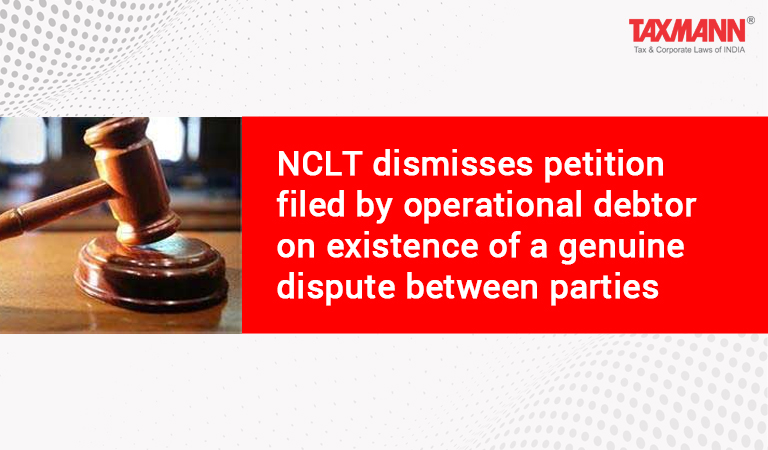NCLT dismisses petition filed by operational debtor on existence of a genuine dispute between parties
- Blog|News|Insolvency and Bankruptcy Code|
- 2 Min Read
- By Taxmann
- |
- Last Updated on 20 July, 2021
Case details: MPT Sweden AB v. Technoweld Alloys (P.) Ltd. - [2021] 128 taxmann.com 94 (NCLT- Chennai)
Judiciary and Counsel Details
-
- R. Sucharitha | Judicial Member & B. Anil Kumar | Technical Member
- V. Prasanth Kiran, Adv. for the Petitioner.
- Thriyambak J. Kannan, Adv. for the Respondent.
Facts of the Case
The Operational creditor and corporate debtor entered into sales confirmation (contract) for the supply of high carbon ferrochrome materials to the latter. Consequently, the Operational creditor supplied materials and issued invoices from time to time as per terms of sales confirmation contracts.
However, despite repeated assurances to clear outstanding operational debt payable to operational creditor, the corporate debtor defaulted in making payments. On being aggrieved, the Operational creditor sent demand notice under section 8 demanding payment of an unpaid operational debt due from the corporate debtor.
The Operational creditors received a notice from the corporate debtor in which dispute was raised with respect to part of debt based on unsupported documents. The Operational creditor filed an application under section 9 to initiate the Corporate Insolvency Resolution Process against the corporate debtor.
The Corporate debtor contended that there was a pre-existing dispute in respect of invoices that were raised after May 2018. Moreover, from a conjoint reading of all e-mails exchanged between parties as well as respective invoices, it was evident that there existed a dispute between parties before issuance of demand notice and said the dispute was still in existence.
NCLT Held
Since there was a genuine dispute between parties and defence raised by the corporate debtor on grounds of existence of a dispute was real and not spurious, hypothetical, illusory or misconceived. Thus, the application for initiation of CIRP against corporate debtor was to be dismissed.
List of Cases Referred to
Disclaimer: The content/information published on the website is only for general information of the user and shall not be construed as legal advice. While the Taxmann has exercised reasonable efforts to ensure the veracity of information/content published, Taxmann shall be under no liability in any manner whatsoever for incorrect information, if any.

Taxmann Publications has a dedicated in-house Research & Editorial Team. This team consists of a team of Chartered Accountants, Company Secretaries, and Lawyers. This team works under the guidance and supervision of editor-in-chief Mr Rakesh Bhargava.
The Research and Editorial Team is responsible for developing reliable and accurate content for the readers. The team follows the six-sigma approach to achieve the benchmark of zero error in its publications and research platforms. The team ensures that the following publication guidelines are thoroughly followed while developing the content:
- The statutory material is obtained only from the authorized and reliable sources
- All the latest developments in the judicial and legislative fields are covered
- Prepare the analytical write-ups on current, controversial, and important issues to help the readers to understand the concept and its implications
- Every content published by Taxmann is complete, accurate and lucid
- All evidence-based statements are supported with proper reference to Section, Circular No., Notification No. or citations
- The golden rules of grammar, style and consistency are thoroughly followed
- Font and size that’s easy to read and remain consistent across all imprint and digital publications are applied








 CA | CS | CMA
CA | CS | CMA


